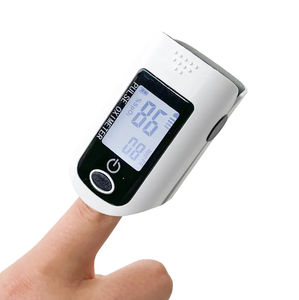
- Primary care
- General practice
- Fingertip pulse oximeter
- Zhengzhou Olive Electronic Technology
Fingertip pulse oximeter OLV-80Amedicalbattery-poweredwireless
Add to favorites
Compare this product
Characteristics
- Configuration
- fingertip
- Applications
- medical
- Options
- battery-powered, wireless, OLED
- Color
- white
- Pulse rate
Min.: 30 unit
Max.: 240 unit
- Oxygen level
Min.: 70 %
Max.: 99 %
Description
The Finger Pulse Oximeter drive a red LED (660 nm) and an infrared LED (910 nm). The blue line indicates the induction curve of the receiver tube to the reduced hemoglobin when the hemoglobin is not an oxygen-containing molecule. The reduced hemoglobin Can be seen from the graph. The absorption of red light at 660 nm is relatively strong, while the absorption length at infrared light at 910 nm is relatively weak. The red line indicates the sensor-to-oxygenated hemoglobin sensing curve of hemoglobin with hemoglobin. With oxygen molecule. From the figure, it can be seen that the absorption of red light at 660 nm is relatively weak, and the absorption at 910 nm is relatively strong. In the measurement of blood oxygen, the reduction of hemoglobin and aerobic haemoglobin, By detecting the difference between the two different wavelengths of light absorption, the measured data difference is the most basic measurement of blood oxygen saturation data. In the blood oxygen test, the two most comm On wavelengths at 660nm and 910nm, in fact, to achieve higher accuracy, in addition to two wavelengths but also to increase, even up to 8 wavelengths, the main reason is that in addition to the reduction of human hemoglobin In addition to hemoglobin and oxyhemoglobin , there are other hemoglobins. We often see carboxyhemoglobin, and more wavelengths help you do better
Catalogs
No catalogs are available for this product.
See all of Zhengzhou Olive Electronic Technology‘s catalogsOther Zhengzhou Olive Electronic Technology products
Medical Oxygen Equipment
Related Searches
- SpO2 monitor
- Nebuliser
- Hospital pulse oximeter
- Fingertip pulse oximeter
- Nebuliser with mask
- General purpose nebuliser
- Nebuliser with compressor
- Hand-held nebuliser
- Battery-powered pulse oximeter
- Electronic nebuliser
- White pulse oximeter
- Wireless pulse oximeter
- Table nebuliser
- OLED pulse oximeter
- Compact pulse oximeter
- Home care pulse oximeter
- Vibrating mesh nebulizer
- Black pulse oximeter
- Compact nebuliser
- Pediatric nebulizer
*Prices are pre-tax. They exclude delivery charges and customs duties and do not include additional charges for installation or activation options. Prices are indicative only and may vary by country, with changes to the cost of raw materials and exchange rates.



















































































